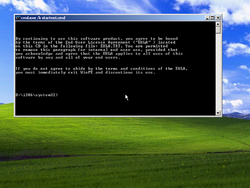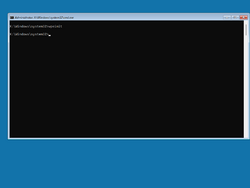Windows Preinstallation Environment
| Component of Microsoft Windows | |
 Windows Preinstallation Environment based on Windows XP Service Pack 1 | |
 Windows Preinstallation Environment based on Windows 11 build 22000.1 | |
| Introduced in | Windows XP build 2257 |
|---|---|
Windows Preinstallation Environment, often shortened to WinPE or Windows PE, is a minimal version of Windows typically used for system deployment or recovery. It is configured in such a way that changes made to the environment do not persist across reboots, which makes it possible to boot it from read-only media such as optical discs or across the network. It was first introduced in Windows XP as a replacement for MS-DOS-based boot disks and has since been adopted for the setup and the recovery environment starting with Windows Vista.
In Windows XP, the environment is loaded by setupldr.bin in a similar manner to the text mode setup. However, it does not load the operating system into a RAM disk by default and therefore it is required to keep the system disk in the drive, as ejecting it would cause the system to misbehave. In Windows Vista, the system is stored inside a WIM file called boot.wim, which is loaded by the boot manager into a RAM disk and then executed. Unlike regular versions of Windows, Windows PE uses the /MININT switch to instruct the kernel to load registry hives as volatile to ensure that the operating system does not attempt to save any registry changes to the boot disk.
Since Windows Vista, Windows PE configurations ship with a utility (wpeutil.exe) which allows simple configuration tasks to be done to the runtime, such as enabling or disabling a firewall, initializing a network, setting regional settings or shutting down or restarting the system.
Appearance[edit | edit source]
The environment used the Windows Classic theme up to version 3.0 (based on Windows 7), as it didn't include support for visual styles, although it did at first include some elements such as the newer Aero cursors. The theme service was introduced in WinPE 4.0 (based on Windows 8) together with the Windows Aero theme, although it falls back to Windows Basic window frames due to Desktop Window Manager not being included. Parts of the Aero theme resources were since removed from the Preinstallation Environment as of the original Windows 10 release, leaving behind a variant where the font falls back to Segoe UI Italic in most visual aspects (except the setup application, which has its own font file bundled) and the cursor scheme reverted to the original pre-Vista variation.
Derivatives[edit | edit source]
Windows Recovery Environment[edit | edit source]
The Windows Recovery Environment (WinRE) is a diagnostic tool suite used for troubleshooting system-level issues that prevent a Windows installation from booting properly. It is the successor to the Recovery Console, a command-line tool included from Windows 2000 to Windows Server 2003.
It was introduced with Windows Vista as a tool available on the setup disc. Since Windows 7 and some OEM releases of Windows Vista, the Recovery Environment is installed along with the rest of the operating system into a hidden partition. This allows the boot loader to automatically start the recovery environment whenever it deems it necessary.
Diagnostics and Recovery Toolset[edit | edit source]
The Microsoft Diagnostics and Recovery Toolset (DaRT), previously Emergency Repair Disk Commander (ERD Commander) is a diagnostic tool suite used for troubleshooting system-level issues that prevent a Windows installation from booting properly.
DaRT can be obtained via the Microsoft Desktop Optimization Pack, which is available as a benefit for Microsoft Software Assurance subscribers.
Unlike Windows Recovery Environment, DaRT comes with extra tools not present in WinRE. These includes:
- Locksmith: Resets a user account's password.
- Crash Analyzer: Analyzes crash dumps.
- File Restore: Restores deleted files.
- Disk Wipe: Irrecoverably erases data from hard disk.
- Windows Explorer (albeit having a simple interface)
- Solution Wizard: A guidance tool that helps user choose the proper repair tool.
- TCP/IP Config: Displays and modifies TCP/IP configuration.
- Search: Searches a disk for files.
- Defender (formerly Standalone System Sweeper): An antivirus that scans a system for malware, rootkits, and potentially unwanted software.
Older versions of ERD Commander used to come with more tools, including a web browser.
List of versions[edit | edit source]
| Version | Based on | Brand name | Notes |
|---|---|---|---|
| 1.0 | Windows XP | — | First version; only available to volume customers |
| 1.1 | Windows XP Service Pack 1 | — | — |
| 1.2 | Windows Server 2003 | — | — |
| 1.5 | Windows XP Service Pack 2 | Windows PE 2004 | — |
| 1.6 | Windows Server 2003 Service Pack 1 | Windows PE 2005 | — |
| 2.0 | Windows Vista | — | First freely available version |
| 2.1 | Windows Vista Service Pack 1 | — | — |
| 2.2 | Windows Vista Service Pack 2 | — | — |
| 3.0 | Windows 7 | — | — |
| 3.1 | Windows 7 Service Pack 1 | — | — |
| 4.0 | Windows 8 | — | — |
| 5.0 | Windows 8.1 | — | — |
| 5.1 | Windows 8.1 Update 1 | — | Manually applied update for WinPE 5.0 |
| 10.0 | Windows 10 | Windows PE for Windows 10 | New WinPE builds are released in sync with Windows 10 feature updates |
| Windows 11 | Windows PE for Windows 11 | New WinPE builds are released in sync with Windows 11 feature updates |
